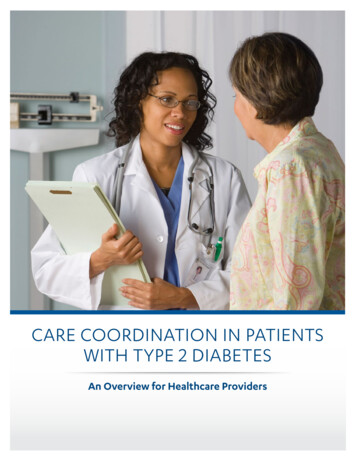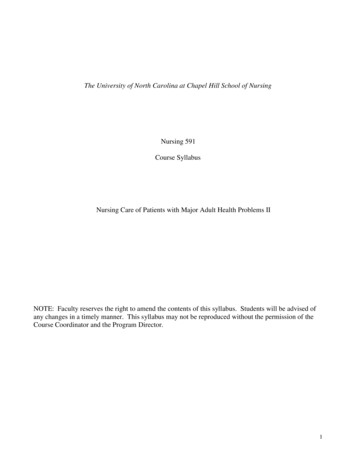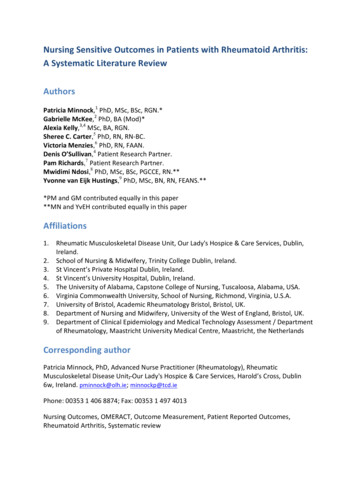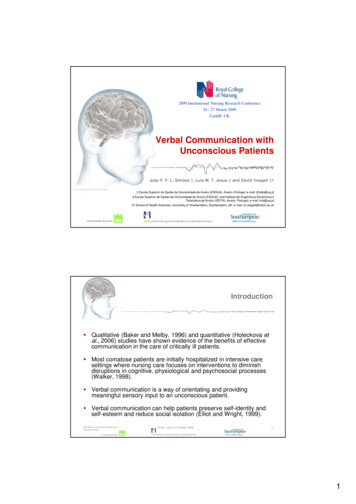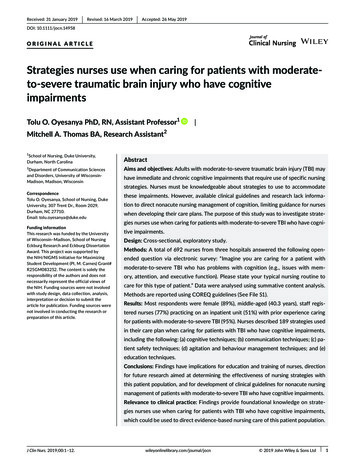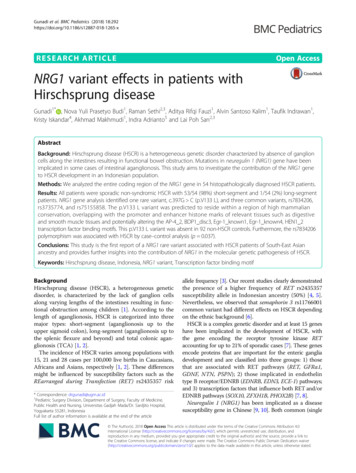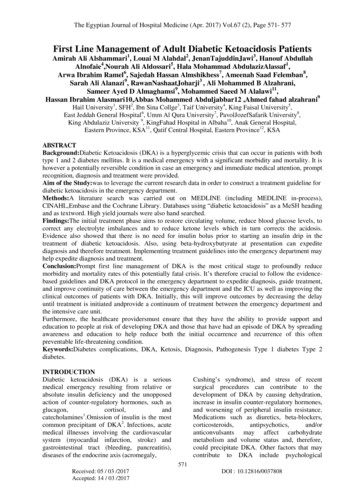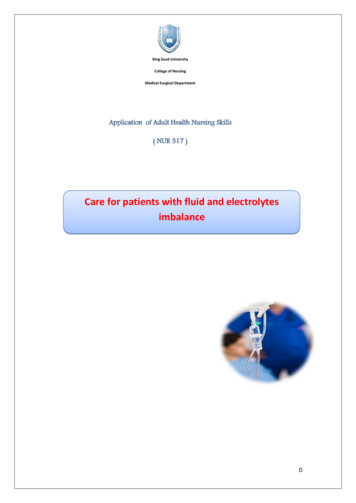
Transcription
King Saud UniversityCollege of NursingMedical Surgical DepartmentApplication of Adult Health Nursing Skills( NUR 317 )Care for patients with fluid and electrolytesimbalance0
Outline of lecture; IntroductionFluid and electrolytes balanceFluid and electrolytes imbalanceAssessment of Edema, DehydrationMeasuring intake and outputIVF ( intravenous fluids)1
Care for patients with fluid and electrolytes imbalanceNormal anatomy and physiologyWater comprises 60% of the body weight of an averageadult, the total body water is divided functionally into theextracellular (ECF 20% of body weight) and theintracellular fluid spaces (ICF 40% of body weight)separated by the cell membrane.The ECF is further divided into the intravascular (within thecirculation) and the interstitial (extravascular fluidsurrounding the cells) fluid space.Fluid Functions: Help regulate body temperatureTransport nutrients and gases throughout the bodyCarry cellular waste products to excretion sitesElectrolytes :Electrolytes are a major component of body fluids that play important roles in maintainingchemical balance, there are six major electrolytes; sodium, potassium,calcium, chloride,phosphorus, and magnesium.Major IntracellularElectrolytesPotassium (K )Magnesium (Mg )Phosphorus/Phosphate (P-)Major ExtracellularElectrolytesSodium (Na )Calcium (Ca )Functions Regulates cell excitability & nerve impulse conduction Permeates cell membranes, thereby affecting the cell’s electrical status(resting membrane potential) Regulates muscle contraction and myocardial membrane responsiveness Modifies nerve impulse transmission and skeletal muscle response Important in the functioning of the heart, nerves, and muscles Influences normal function of the cardiovascular system and Na and K iontransportation Promotes energy storage and carbohydrate, protein and fat metabolismFunctions Helps maintain acid base balance Activates nerve and muscle cells Influences water distribution (with chloride) Found in cell membranes it helps cells adhere to one another and maintain their shape Acts as an enzyme activator within cells (muscles must have Ca to contract) Aids in coagulation promotes nerve impulse and muscle contraction/relaxation2
Sodium (Na)Normal rang: 135-145 mEq/LCauses of elevation (Hypernatremia)Water loss, inadequate water intake, excessive sodiumintake, Diabetes Insipidus (DI), certain diuretics,corticosteroid use, antihypertensive drug.Signs/Symptoms Thirst, dry sticky mucous membranes;Restlessness, disorientation,Muscle weakness and irritabilityCauses of decline (Hyponatremia)Inadequate sodium intake, Excessive water gain caused byinappropriate administration of I.V. solutions, heart andrenal failure, cirrhosis, laxatives, nasogastric suctioning,Medications such as antidiabetics, diuretics.Signs/Symptoms Nursing Intervention Confusion Orthostatic hypotensionNausea, vomitingWeight gain, EdemaMuscle spasms, convulsionsNursing InterventionIdentify patients at risk for hypernatremia. Identify patients at risk for hyponatremia.Assess the patient for fluid losses. Assess fluid intake and output.Assess the patient for signs and symptoms Assess the patient for signs and symptomsofhypernatremia.ofhyponatremia.Consult with a nutritionist to determine Restrict fluid intake.Encourage the patient to increase his fluidintake but Administerisotonic I.V. fluids.decrease his sodium intake. that ensure appropriate fluid and sodium intake.Teach the patient and his family how toprevent,recognize, and treat hypernatremiaPotassium ( K)Normal Level 3.5 - 5 mEq/LCauses of elevation (Hyperkalemia)Causes of decline (Hypokalemia)High potassium intake related to the improper use of oralsupplements, excessive use of salt substitutes, or rapidinfusion of potassium solutions.Signs/SymptomsGI losses from diarrhea, laxative abuse, prolonged gastricsuctioning, prolonged vomiting. fatigue, muscle weaknessorthostatic hypotensioncardiac arrestSuppressed insulin release and aldosterone secretionRespiratory muscle weakness slightly elevated glucoselevelNursing Intervention Identify patients at risk for hypokalemia.Assess the patient’s diet for a lack ofpotassium.Assess the patient for signs and symptoms ofhypokalemia.Administer a potassium replacement asprescribed.Encourage intake of high-potassium foods,such asbananas, dried fruit, and orange juice.Monitor the patient for complications.Have emergency equipment available for cardiopulmonaryresuscitation and cardiac defibrillation.arrhythmias,decreased strength of contraction,and cardiac arrestNausea, vomiting, diarrhea,intestinal colic, uremic enteritis,decreased bowel sounds, abdominal distention.Signs/SymptomsNursing Intervention Identify patients at risk for hyperkalemia.Assess for signs and symptoms of hyperkalemia.Have emergency equipment available.Administer calcium gluconate to decreasemyocardial irritability. Administer insulin and I.V. glucose to movepotassium back into cells. Carefully monitor serum glucose levels. Administer sodium polystyrene sulfonate(Kayexalate) with 70% sorbitol to exchange sodium ions forpotassium ions in the intestine 3
CalciumNormal Level 4.5 – 5.5 mEq/LCauses of elevation (hypercalcemia)Causes of decline (hypocalcemia)Metastatic bone cancer, hyperparathyroidism,High calciumintake, Hyperthyroidism or hypothyroidismSigns/Symptomsacute pancreatitis, inadequate dietary intake of vitamin D,longterm use of laxatives, thyroid carcinoma, loop diuretics.Signs/Symptoms Muscle weakness and lack of coordinationAnorexia, constipation, abdominal pain, nausea,vomiting, peptic ulcers, and abdominal distentionConfusion, impaired memory,slurred speech, and comaCardiac arrestNursing InterventionAssess the patient for signs and symptoms ofhypercalcemia. Encourage ambulation. Move the patient carefully to prevent fractures. Administer phosphate to inhibit GI absorptionof calcium. Administer a loop diuretic to promote calcium excretion. Reduce dietary calcium. Tingling around the mouth and in the fingertips and feet,numbness,painful muscle spasms.Positive Chvostek’s signs or Positive trousseau's singsSeizuresconfusion, and hallucinationsSkeletal fractures resulting from osteoporosisNursing InterventionAssess the patient for signs and symptoms ofhypocalcemia, especially changes in cardiovascularand neurologic status and in vital signs.Administer I.V. calcium as prescribed.Administer a phosphate-binding antacid.Take seizure or emergency precautions asneeded.Encourage the patient to increase his intake of foods thatare rich in calcium and vitamin D.Magnesium ( Mg)Normal level 1.5 - 2.5 mEq/LCauses of elevation (Hypermagnesemia)Renal failure, adrenal insufficiency, or diuretic abuseExcessive magnesium replacement or excessive useof milk of magnesia .Signs/Symptoms Peripheral vasodilation with decreased blood pressure,Facial flushing and sensations of warmth and thirstLethargy or drowsiness, apnea, and comaLoss of deep tendon reflexes, paresis.Cardiac arrestCauses of decline (Hypomagnesemia)malnutrition, malabsorption anorexia, intestinal bypass forobesity, diarrhea, diuretics or antibiotics, such as gentamicin,Overdose of vitamin D or calcium, burns, pancreatitis, ordiabetic ketoacidosisSigns/Symptoms Nursing Intervention Review all medications for a patient with renal failure.Assess the patient for signs and symptoms ofhypermagnesemia.Assess reflexes; if absent, notify the practitioner.Administer calcium gluconate.Muscle weakness, tremors, Seizure .Decreased blood pressure, ventricularfibrillation, tachyarrhythmias,depression, agitation, confusion, and hallucinationsNausea, vomiting, and anorexiaDecreased calcium levelNursing Intervention Assess the patient for signs and symptoms ofhypomagnesemia.Administer I.V. magnesium as prescribed.Encourage the patient to consume magnesium-richfoods.4
Prepare the patient for hemodialysis if prescribed.If the patient is taking an antacid, a laxative, or anotherdrug that contains magnesium, instruct him to stop.Teach the patient and his family how to prevent,recognize, and treat hypermagnesemia If the patient is confused or agitated, take safetyprecautions.Take seizure precautions as needed.Teach the patient and his family how to prevent,recognize, and treat hypomagnesemiaPhosphorus (p)Normal level 2.5 - 4.5 mg/dlCauses of elevation (Hyperphosphatemia)Causes of decline (Hypophosphatemia)Renal disease, Hypoparathyroidism or hyperthyroidism,Excessive vitamin D intake, Muscle necrosis, excessivephosphate intake, or chemotherapySigns/SymptomsGlucose administration or insulin release, respiratoryalkalosis, Malabsorption syndromes, diarrhea, vomiting,aldosteronism, diuretic therapy.Signs/Symptoms Soft-tissue calcification (chronic hyperphosphatemia)Hypocalcemia, possible with tetanyIncreased red blood cell count Irritability, confusion, decreased level of consciousness,seizures, and comaWeakness, numbness, and paresthesiaRespiratory muscle weaknesselevated creatine kinase level,hyperglycemia, and metabolic acidosisNursing Intervention Assess the patient for signs and symptoms ofhyperphosphatemia and hypocalcemia, includingtetany and muscle twitching.Advise the patient to avoid foods and medications thatcontain phosphorus.Administer phosphorus-binding antacids.Prepare the patient for possible dialysis.Nursing Intervention Assess the patient for signs and symptoms of hypophosphatemia, especially neurologic.Administer phosphate supplements as prescribed.Note calcium and phosphorus levels because calcium andphosphorus have an inverse relationship.Fluid and electrolyte imbalancesFluid and electrolyte balance is essential for health. Many factors, such as illness, injury, surgery,and treatments, can disrupt a patient’s fluid and electrolyte balance. Even a patient with a minorillness is at risk for fluid and electrolyte imbalance.Fluid Volume Deficit (Hypovolemia)Fluid Volume Excess (Hypervolemia)The body loses water all the time. A person responds to thethirst reflex by drinking fluids and eating foods that containwater. However, if water isn’t adequately replaced, thebody’s cells can lose water. This causes dehydration, or fluidvolume deficit. Dehydration refers to a fluid loss of 1% ormore of body weightHypervolemia refers to an excess of fluid (water andsodium) in ECF. The body has compensatory mechanismsto deal with hypervolemia. However, if these fail, signs andsymptoms develop.Etiology/Cause Hemorrhage Vomiting Diarrhea Burns Diuretic therapy Fever Impaired thirstEtiology/Cause Congestive Heart Failure Early renal failure IV therapy Excessive sodium ingestion Corticosteroid5
Fluid Volume Deficit (Hypovolemia)Signs/Symptoms; Fluid Volume Excess (Hypervolemia)Signs/Symptoms;Mild Fluid Loss:Orthostatic hypotension, Increased heart rateRestlessness, anxietyWeight lossModerate Fluid Loss:Confusion, dizziness, irritabilityExtreme thirstNausea -Cool, clammy skinRapid PulseDecreased urine output (10-30 ml/hr)Severe Fluid Loss:Decreased cardiac outputUnconsciousnessHypotensionWeak or absent peripheral pulses Tachypnea ,Dyspnea, cracklesRapid or bounding pulseHypertension (unless in heart failure)Distended neck and hand veinsAcute weight gainEdemaPulmonary edema- Dyspnea-Orthopnea (diff. breathing when supine)-cracklesAssessing fluid balanceThere are three elements to assessing fluid balance and hydration status: Review of fluid balance charts;Clinical assessment;Review of blood chemistry.1- Review of fluid balance charts;Fluid balance means the amount of fluid intake equal the amount of fluid excreted . Intake include; water, juice, tea and coffe, IV fluid , NG feeding Output include; urine, emesis, NG drainage, and blood drainage. Record all fluid intake in the sheet and calculate the total at the end of each shift Record all fluid output remember if patients on urine catheter each shiftempty urine from catheter. IF Intake ( I ) more than Output (O) look for signs of edema IF Intake ( I ) less than Output (O) look for signs of dehydration2- Nursing assessment for dehydration Observations Vital signs, such as pulse, blood pressureand respiratory rate, will change when a patientbecomes dehydrated Skin elasticity The elasticity of skin, or turgor, is anindicator of fluid status in most patients. However, thisassessment can be an unreliable indicator of dehydrationin older people as skin elasticity reduces with age2- Nursing assessment for edema6
Medical treatmentMedical treatment Treatment involves determining the cause(such as diarrhea or decreased fluid intake) andreplacing lost fluids either orally or I.V. Treatment involves determining the cause andtreating the underlying condition. Most patients receive hypotonic, low sodiumfluids such as dextrose 5% in water (D5W). Typically, patients require fluid and sodiumrestrictionsDiuretics therapy may be ordered if renal failure isnot the cause. I.V. fluid replacementThe doctor may order I.V. fluid to maintain or restore fluid balance. I.V. fluid replacement fall into the broadcategories of crystalloids and colloids;A.Colloids - contain larger insoluble molecules (blood, albumin, plasma) used to increase the bloodvolume following severe loss of blood (haemorrhage) or loss of plasma ( severe burns).B.Crystalloids – contains aqueous solutions of mineral salts or other water-soluble molecules ( salts andsugar.) to correct body fluids and electrolyte deficit IsotonicA solution that has the same salt concentration as the normal cells of the body and the blood.Examples: Ringer Lactate .0.9% NaCl (0.9% NSS )D5W.Normal salinesame tonicity as bodyIndication: Hypotension (increases BP), HypovolemiaComplications of Isotonic IV fluid overload7
HypertonicA solution with a higher salts concentration than in normal cells of the body and the blood.Examples : D5W in normal Saline solution , D5W in half
Nursing Intervention Nursing Intervention Review all medications for a patient with renal failure. Assess the patient for signs and symptoms of hypermagnesemia. Assess reflexes; if absent, notify the practitioner. Administer calcium gluconate. Assess the patient for signs and symptoms of hypomagnesemia.


